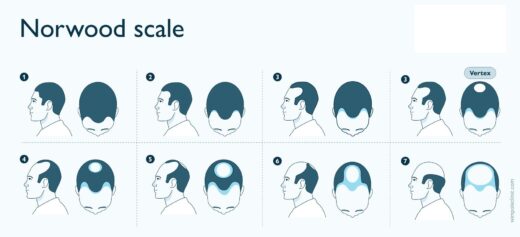Male pattern baldness, also known as androgenetic alopecia, can evoke a range of emotions—frustration, concern, or even discouragement. However, one thing it isn’t is unpredictable. As the name suggests, this type of hair loss follows a distinct and recognizable pattern. It typically begins at the hairline, which may gradually recede to form an ‘M’ shape at the widow’s peak. Over time, the hair at the mid-crown thins and shortens, eventually leading to a bald patch. In the most advanced stages, only a thin band of hair remains around the sides and back of the scalp. In the 1950s, this progression was meticulously studied and divided into seven stages, now known as the Norwood Scale.

The Norwood Scale is a diagnostic tool specifically designed to assess male hair loss (while the Ludwig Scale is used for women). To effectively address hair loss, a doctor must evaluate its severity, progression, and other factors such as age and family medical history. Below, we’ll explore each stage of the Norwood Scale, the options available for treatment—including prescription medications, topical solutions, and hair transplants—and how to determine which stage you may be in.
What is the Norwood Scale?
The Norwood Scale, also referred to as the Hamilton-Norwood Scale, is a classification system that outlines the stages of male pattern baldness. It was first introduced by Dr. James Hamilton in the 1950s and later refined by Dr. O’Tar T. Norwood in the 1970s. This updated version remains the gold standard for diagnosing and categorizing male hair loss today.
The scale measures the progression of hair loss, with higher numbers indicating more advanced stages. For instance, a Norwood 1 signifies no noticeable hair loss, while a Norwood 7 represents near-total baldness, with only a horseshoe-shaped band of hair remaining around the sides and back of the head.
Male pattern baldness is primarily driven by dihydrotestosterone (DHT), a hormone derived from testosterone. However, other factors such as age, genetics, ethnicity, and even hair color can influence the extent of hair loss and whether someone is a suitable candidate for a hair transplant.

Hair Loss Stages According to the Norwood Scale
Norwood Class 1
Norwood Class 1 represents a full head of hair with no signs of hair loss. It reflects the natural maturation of the hairline that typically occurs as men transition from adolescence to adulthood. At this stage, there is no indication of balding, and it is considered an age-appropriate hairline.
While it’s possible to remain at Norwood 1 indefinitely, this is relatively rare. If you’re unsure whether your hairline is maturing naturally or if it’s the early signs of male pattern baldness, consulting a professional is the best course of action.
Norwood Class 2
Norwood Class 2 marks the initial stages of a receding hairline, often characterized by the development of a more pronounced widow’s peak. While this stage is not yet considered balding, it can be a source of concern for many men.
This is an ideal time to intervene, as hair loss at this stage is highly treatable. Medications like finasteride and minoxidil can effectively block DHT and slow or halt hair loss. While a hair transplant is typically not recommended at this stage, a qualified specialist can provide personalized advice based on your specific situation.
Norwood Class 3
At Norwood Class 3, hair loss becomes more noticeable, with significant recession at the temples and forehead, forming an M, U, or V shape. Hair thinning at the crown, known as a Class 3 vertex, may also occur at this stage.
This is the point where hair loss is officially classified as balding. Hair transplants become a viable option, particularly for those with a Class 3 vertex who wish to address their balding crown. Younger patients should consider continuing medications like finasteride or minoxidil to prevent further hair loss in other areas.
Norwood Class 4
Norwood Class 4 signifies more advanced balding, with noticeable hair loss at the crown and further recession at the temples. A distinct band of hair typically separates the crown (vertex) from the mid-scalp.
Men at this stage can achieve excellent results from a hair transplant. By strategically transplanting hair to the crown and temples, a skilled surgeon can restore a fuller appearance. Combining this with medication can help maintain the results over time.
Norwood Class 5
At Norwood Class 5, hair loss is more pronounced, with the bridge between the crown and mid-scalp beginning to thin and disappear. The bald areas at the front and crown start to merge, creating a larger bald spot.
Despite the advanced stage, hair transplants can still yield impressive results. The key is to work with an experienced surgeon who can maximize the use of available donor hair.
Norwood Class 6
Norwood Class 6 is characterized by the complete disappearance of the bridge between the crown and mid-scalp, leaving one large bald area. Hair typically remains only around the sides and back of the head.
While hair transplants are still an option at this stage, the results depend on the amount of donor hair available. The goal is to create a natural-looking hairline and coverage using the remaining hair.
Norwood Class 7
Norwood Class 7 represents the most advanced stage of hair loss, with only a horseshoe-shaped band of hair remaining around the sides and back of the scalp. At this point, donor hair may be limited, and patients may need to prioritize which areas to address—whether the frontal area, crown, or mid-scalp.
Despite the challenges, many men at this stage can still achieve satisfying results with a hair transplant, provided they have sufficient donor hair.
Conclusion
Male pattern baldness is a common condition that follows a predictable progression, as outlined by the Norwood Scale. To recap:
- Norwood Stages 1-2: Not yet considered balding. Early intervention with medications like finasteride and minoxidil can be highly effective.
- Norwood Stages 3-5: Hair loss becomes more noticeable. This is the optimal time for treatments such as medications or hair transplants.
- Norwood Stages 6-7: Advanced hair loss, but hair transplants can still provide significant improvements depending on donor hair availability.
Tracking your hair loss progression can help identify its cause. Regularly taking photos of your scalp from different angles and comparing them over time can provide valuable insights. If your hair loss deviates from the typical pattern—such as patchy loss or accompanied by redness, scaling, or pain—it may indicate a different condition, and you should consult a doctor.
No matter where you are in your hair loss journey, Erdem Hospital is here to help. With decades of experience and a commitment to excellence, we’ve helped countless men and women regain their confidence through personalized hair restoration solutions. Schedule a free consultation today to discover how we can assist you in achieving your goals!